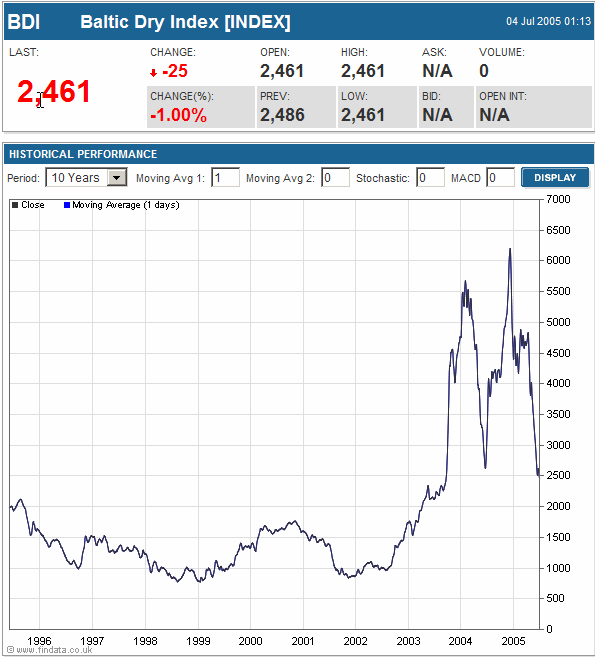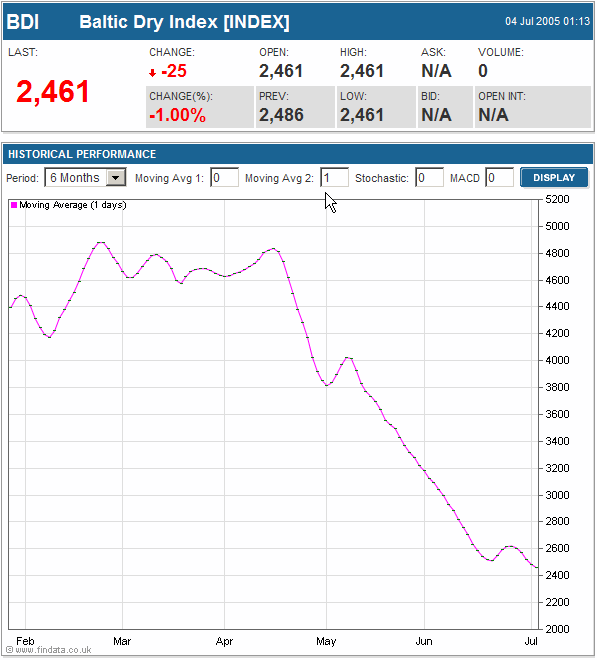
Dynamics

|
Generational Dynamics |
| Forecasting America's Destiny ... and the World's | |
| HOME WEB LOG COUNTRY WIKI COMMENT FORUM DOWNLOADS ABOUT | |
China is causing wild volatility and turmoil in shipping, iron ore and steel prices, and it's anybody's guess how long this can last.
Last month I wrote an article on the Baltic Dry Index (BDI) and its sharp, rapid fall in the last six months. I said that it indicated a possible global economic slowdown in the fall. I've now been able to put together a more complete picture.
The Baltic Dry Index (BDI) measures the shipments of "dry-bulk cargos," commodities like iron ore, grain, cement and coal, shipped in bulk on huge freighters traveling the seas around the world.
 |
The adjoining graph (from the FinData web site) shows the BDI for the last ten years,
The BDI has a colorful history since it was established in 1744 by merchants and ships' captains chitchatting at the Virginia and Baltick Coffee House in Threadneedle Street in London.
The BDI is considered to be a reliable leading economic indicator for manufacturing, since it measures commodities that will eventually be used in the manufacture of finished goods.
As you can see, the BDI followed a fairly steady pattern for many years, until mid-2003. Since then, it's become extremely volatile, and is currently plummeting very rapidly, with sharp decreases almost every day. This means that the cost of shipping dry goods is falling sharply, which means that demand for shipping services is falling. Such a sharp decrease in worldwide shipping demand is a harbinger of a fall in manufacturing in the fall.
The suddenly volatility has been caused by variability in Chinese imports of iron ore. China's economy has been growing at the rate of 9-10% per year for 20 years, and any such exponential growth pattern cannot last long without causing severe market distortions.
By the early 2000s, China's steel production was beginning to be felt around the world. China was importing iron ore and coal for its steel production, but the world price of iron ore was still around a stable $200 per ton.
However, China has needed more and more steel to maintain its explosive growth, to build more and more new factories, to feed its quickly expanding shipyards, and to manufacture goods including cars, household appliances and buildings, many for export shipment to America, Japan and Europe.
Starting in 2003, China's steel output really began to take off, and iron ore prices were rising, so numerous factories began importing iron ore in order to lock in prices. These imports reached a peak early in 2004, which explains the first tall peak in the BDI graph shown above.
The panicky purchase of iron ore created an iron ore glut within the country, and imports fell. This explains the sharp fall in shipping rates in mid-2004, as shown in the above graph.
Soon the glut became a shortage, triggering a boom in the worldwide price of steel, and a revived increased demand for iron ore. By early 2005, the worldwide price of both iron ore and steel had tripled, with steel selling for $750-800 per ton - a three to fourfold increase since 2001. That explains the second peak on the graph above, occurring at the end of 2004. (Paragraph corrected on 4-Nov-2008)
Once again, there was another glut, and shipments fell.
To add to it, China announced a 17% tax on high-end steel products made for processing and sale overseas — such as metal for containers and ships. This has substantially reduced China's demand for iron ore, and that's why worldwide shipping costs began to fall sharply in May, as the above BDI graph shows.
At the present time, there's no way to describe the current situation as anything else but massive turmoil. This volatility has caused huge swings in prices of shipping, iron ore, steel, and related commodities, services and products.
Nobody knows for sure whether the BDI is going to keep falling or is going to level off.
 |
For a few days last month, the BDI began to increase, and some people were predicting that the index would continue to rise again. But at the end of last week, the BDI fell once more, as shown by the adjoining graph.
The turmoil is extending a number of other countries.
India has been building up its steel-making capacity, but now has more capacity that it can use. Instead, India has been shipping huge amounts of iron ore to China, but now analysts are trying to discourage that, because they've discovered that India is going to run out of iron ore in 10-20 years at current rates.
Other countries have been rapidly expanding their steelmaking capacity as well. Brazil's capacity has also been growing rapidly, making it clear that the world can produce more steel that it can use.
The three largest miners of iron ore are Cia. Vale do Rio Doce in Brazil, London-based Rio Tinto, and Melbourne-based BHP Billiton. (Paragraph corrected on 4-Nov-2008)
China's rise as a global steel power has been led by Shanghai Baosteel Group, a state-owned steel manufacturer. China's government has been pushing Baosteel since 1978 to be the world's leading steel producer, so a further dramatic fall in both steel prices and the BDI would not be a surprise.
Indeed, one analyst is predicting that steel prices have already peaked, and are falling.
From the point of view of Generational Dynamics, this kind of volatility and turmoil is typical of an "unraveling" situation that precedes a crisis. China's economy is in a price bubble; America's economy is overwhelmed with debt, and is in a stock market and real estate bubble; Japan's economy is still in a monetary deflationary state, 13 years after its stock market collapse; and Europe is strapped with very high unemployment and decreasing GDP.
Generational Dynamics predicts that we're entering a new 1930s style
Great Depression that will cause a stock market correction of 50% or
more, and a deflation of American currency by 30% or more. All
that's required is some kind of "shock," and that could happen next
week, next month or next year. But it's going to happen with 100%
certainty, and sooner rather than later.
(5-Jul-05)
Permanent Link
Receive daily World View columns by e-mail
Donate to Generational Dynamics via PayPal
Web Log Summary - 2016
Web Log Summary - 2015
Web Log Summary - 2014
Web Log Summary - 2013
Web Log Summary - 2012
Web Log Summary - 2011
Web Log Summary - 2010
Web Log Summary - 2009
Web Log Summary - 2008
Web Log Summary - 2007
Web Log Summary - 2006
Web Log Summary - 2005
Web Log Summary - 2004
Web Log - December, 2016
Web Log - November, 2016
Web Log - October, 2016
Web Log - September, 2016
Web Log - August, 2016
Web Log - July, 2016
Web Log - June, 2016
Web Log - May, 2016
Web Log - April, 2016
Web Log - March, 2016
Web Log - February, 2016
Web Log - January, 2016
Web Log - December, 2015
Web Log - November, 2015
Web Log - October, 2015
Web Log - September, 2015
Web Log - August, 2015
Web Log - July, 2015
Web Log - June, 2015
Web Log - May, 2015
Web Log - April, 2015
Web Log - March, 2015
Web Log - February, 2015
Web Log - January, 2015
Web Log - December, 2014
Web Log - November, 2014
Web Log - October, 2014
Web Log - September, 2014
Web Log - August, 2014
Web Log - July, 2014
Web Log - June, 2014
Web Log - May, 2014
Web Log - April, 2014
Web Log - March, 2014
Web Log - February, 2014
Web Log - January, 2014
Web Log - December, 2013
Web Log - November, 2013
Web Log - October, 2013
Web Log - September, 2013
Web Log - August, 2013
Web Log - July, 2013
Web Log - June, 2013
Web Log - May, 2013
Web Log - April, 2013
Web Log - March, 2013
Web Log - February, 2013
Web Log - January, 2013
Web Log - December, 2012
Web Log - November, 2012
Web Log - October, 2012
Web Log - September, 2012
Web Log - August, 2012
Web Log - July, 2012
Web Log - June, 2012
Web Log - May, 2012
Web Log - April, 2012
Web Log - March, 2012
Web Log - February, 2012
Web Log - January, 2012
Web Log - December, 2011
Web Log - November, 2011
Web Log - October, 2011
Web Log - September, 2011
Web Log - August, 2011
Web Log - July, 2011
Web Log - June, 2011
Web Log - May, 2011
Web Log - April, 2011
Web Log - March, 2011
Web Log - February, 2011
Web Log - January, 2011
Web Log - December, 2010
Web Log - November, 2010
Web Log - October, 2010
Web Log - September, 2010
Web Log - August, 2010
Web Log - July, 2010
Web Log - June, 2010
Web Log - May, 2010
Web Log - April, 2010
Web Log - March, 2010
Web Log - February, 2010
Web Log - January, 2010
Web Log - December, 2009
Web Log - November, 2009
Web Log - October, 2009
Web Log - September, 2009
Web Log - August, 2009
Web Log - July, 2009
Web Log - June, 2009
Web Log - May, 2009
Web Log - April, 2009
Web Log - March, 2009
Web Log - February, 2009
Web Log - January, 2009
Web Log - December, 2008
Web Log - November, 2008
Web Log - October, 2008
Web Log - September, 2008
Web Log - August, 2008
Web Log - July, 2008
Web Log - June, 2008
Web Log - May, 2008
Web Log - April, 2008
Web Log - March, 2008
Web Log - February, 2008
Web Log - January, 2008
Web Log - December, 2007
Web Log - November, 2007
Web Log - October, 2007
Web Log - September, 2007
Web Log - August, 2007
Web Log - July, 2007
Web Log - June, 2007
Web Log - May, 2007
Web Log - April, 2007
Web Log - March, 2007
Web Log - February, 2007
Web Log - January, 2007
Web Log - December, 2006
Web Log - November, 2006
Web Log - October, 2006
Web Log - September, 2006
Web Log - August, 2006
Web Log - July, 2006
Web Log - June, 2006
Web Log - May, 2006
Web Log - April, 2006
Web Log - March, 2006
Web Log - February, 2006
Web Log - January, 2006
Web Log - December, 2005
Web Log - November, 2005
Web Log - October, 2005
Web Log - September, 2005
Web Log - August, 2005
Web Log - July, 2005
Web Log - June, 2005
Web Log - May, 2005
Web Log - April, 2005
Web Log - March, 2005
Web Log - February, 2005
Web Log - January, 2005
Web Log - December, 2004
Web Log - November, 2004
Web Log - October, 2004
Web Log - September, 2004
Web Log - August, 2004
Web Log - July, 2004
Web Log - June, 2004